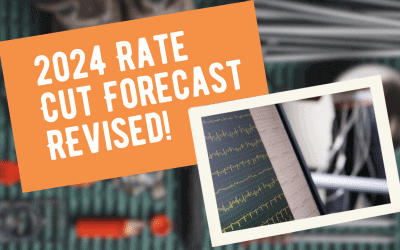Canada’s economic growth figures for the second quarter of 2023 have been labeled as “disappointing” by economists, casting doubt on whether the Bank of Canada will proceed with its planned interest rate hike in September. The latest data, released by Statistics Canada, reveals a slowdown in the country’s gross domestic product (GDP) growth, which fell short of expectations and has been attributed to various factors impacting different sectors of the economy.
Some economists, including CIBC’s Benjamin Tal have already expressed concern that the Bank of Canada went too far increasing interest rates, but that also the Bank has more tools at it’s disposal to fight a recession than it does inflation,
Slower Growth in Q2 than Expected
According to the report, Canada’s GDP rose by a modest 0.3% in May, slightly lower than what economists had predicted. This followed a revised growth rate of 0.1% in April. Looking ahead, the preliminary estimate for June shows a 0.2% contraction, which would result in an annualized growth rate of approximately 1% to 1.2% for the second quarter. This represents a significant slowdown from the 3.4% growth rate recorded in the first quarter and is below the Bank of Canada’s forecast of 1.5% growth for Q2, as stated in its latest Monetary Policy Report.
This is in contrast to US data where GDP growth exceeded expectations by 33% with a 0.27% increase in June for an Annualized rate of 3.4%.
Factors Impacting Growth
Economists have pointed out various factors contributing to the disappointing growth figures. BMO chief economist Douglas Porter highlighted that the under-performance of the Canadian economy was expected due to the impacts of wildfires, a civil servant strike, and production issues in the automotive sector. He further observed that “while the June handoff to Q3 is soft, we suspect that that weakness will reverse in the summer.”
The report from Statistics Canada showed that 12 out of 20 sectors experienced growth in May. Wholesale trade and manufacturing were among the sectors with the largest gains, benefiting from increased auto production as chip shortages continued to be addressed. Additionally, the real estate sector remained a bright spot in the economy, with strong demand and reselling activity in major markets like Toronto, Vancouver, and Calgary contributing to its growth.
However, the gains in some sectors were offset by a 2.9% decline in mining and oil and gas due to the slowdown in energy production caused by wildfires.
Impact on Bank of Canada’s Rate Decision
This is the part that we are most interested in. Since early 2022 the Bank of Canada has continued to hammer Canadians with interest rate increases. Variable rate holders especially are crying for some relief from the high-interest rates.

The softening economic growth and the potential for contraction have led some economists to suggest that the Bank of Canada may halt any further rate hikes in the near future. Slower growth in the second half of the year could prompt the central bank to maintain its current interest rate policy to balance the risks of over-tightening or under-tightening monetary policy.
TD economist Marc Ercolao echoed this sentiment, stating that the recent data points to a slowdown in economic momentum as the country heads into the summer. He expects the Bank of Canada to remain on hold at its next meeting in September.
While many economists agree on the potential impact of disappointing growth data on the Bank of Canada’s rate decision, there are differing opinions on the overall strength of the Canadian economy. Some economists, like Derek Holt of Scotiabank, argue that the economy is considerably stronger than the GDP figures suggest. Holt believes that various distortions have affected the official statistics and that the economy may have been tracking double the growth rate in Q2.
Looking Forward: Employment Figures as a Key Indicator
With economists closely monitoring the country’s economic performance, the upcoming July employment figures from Statistics Canada will be crucial in assessing the health of the labor market and its impact on the central bank’s rate decision. Those will be released on August 4, 2023. Signs of continued loosening in the labor market and trends in core inflation could further influence the Bank of Canada’s stance on interest rates.
Canada’s disappointing growth data in Q2 2023 raises concerns about the country’s economic trajectory and the potential impact on the Bank of Canada’s monetary policy. Slower growth and potential contractions may deter the central bank from raising interest rates in September, as policymakers seek to balance economic stability and manage inflationary pressures. The July employment figures will be closely watched by economists as they gauge the economy’s health and its implications for the future course of monetary policy. Watch for the next update!






0 Comments
Trackbacks/Pingbacks